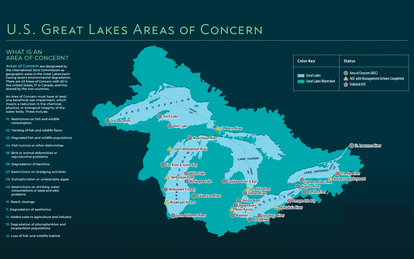Realizing the Value of the Great Lakes Restoration Initiative

While the President’s Budget has included a 90% reduction in funding for the Great Lakes Restoration Initiative (GLRI) the past three years, bipartisan political support for the program runs deep. Full funding for the GLRI was added back into the Federal budget in May 2019, due to broad-based advocacy for its ecological and economic value.
The GLRI started in 2010, with a goal to clean up and restore the most polluted and environmentally impaired areas of the Great Lakes. More than 4,000 projects have been funded since then, with a focus on improving water quality, restoring habitat, and fighting the growth in invasive species.
Many of these projects are contributing towards ongoing efforts to delist Areas of Concern (AOCs) within the watershed. In 1987, building on the binational Great Lakes Water Quality Agreement, the U.S. and Canada identified a list of 43 geographic areas that were most impaired by environmental degradation. Over the past three decades, bringing these AOCs back to life has been a top priority for Great Lakes clean-up and restoration efforts. The GLRI awarded roughly one-third of its funding to AOC-related projects from 2010-2014.
The GLRI’s return-on-investment goes well past delisting former AOCs. A research study released last fall by the University of Michigan’s Research Seminar in Quantitative Economics shows that every federal dollar spent on GLRI projects from 2010 through 2016 will produce $3.35 of additional economic activity in the Great Lakes region through 2036.
This study quantifies what many Great Lakes advocates have long believed: that public investment in improved water quality and environmental health contributes directly to the region’s economic improvement and growth. As Jennifer Read, Director of the University of Michigan’s Water Center, put it, “We have long suspected that the health of the Great Lakes is an important driver of our regional economy, but it is fantastic to now have a clear and quantitative demonstration of that connection.” Far from being antithetical to economic growth, environmental stewardship is a key contributor to it throughout the Great Lakes.